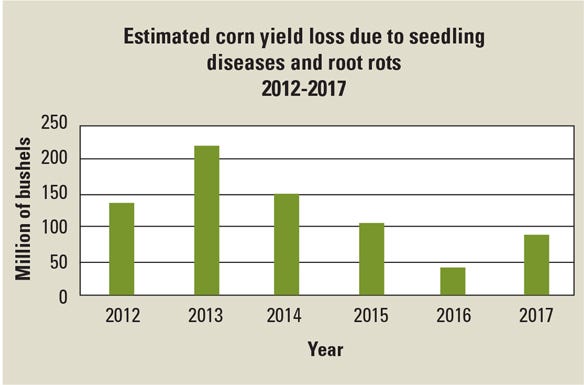January 29, 2019

Pythium species are one of the major pathogens in Iowa known to cause seed and seedling diseases in corn. Affected seedlings are generally scattered in the wetter areas of the field, and plants appear yellow and wilted or even dead. Seedling diseases can result in stand loss or reduced vigor that leads to major yield losses.
Estimated yield loss due to seedling diseases and root rots are made by plant pathologists in the U.S. and in Ontario. Those losses in recent years are summarized in the accompanying chart. With Iowa being a leading corn-producing state, the potential economic impact of seedling diseases is high.

Conditions favoring disease
Soil conditions after planting have a direct impact on the length of time it takes corn to germinate and emerge. It may take more than three weeks for corn to emerge when soil temperatures are 50 to 55 degrees F, whereas when the soil temperature is 70, corn can emerge in less than a week. Cool and wet conditions delay emergence and are favorable for seedling disease, particularly disease caused by Pythium, because the pathogen has a longer time period to infect seeds or seedlings.
Additionally, previous crop residues may also contribute to a favorable environment for seedling pathogens. For instance, research has shown that planting too soon after terminating a cereal rye cover crop can increase the risk for seedling diseases in corn.
Seed treatments available
Fungicide seed treatments are used to reduce damage by seedling pathogens, but they only provide protection to germinating seedlings for a short window after planting. Most corn is treated with a seed treatment that contains a number of fungicides.
Not all fungicide seed treatments are effective on Pythium. Current fungicide seed treatments that specifically target Pythium include metalaxyl (Allegiance) mefenoxam (Apron XL) and ethaboxam (Intego).
Research on new active ingredients effective on Pythium is ongoing. One new active ingredient that targets Pythium is picarbutazox, and it is scheduled for registration on corn and soybean in the U.S. in 2020.
Lessons learned from trials
Efforts are being made to gain a greater understanding of Pythium-causing seedling disease and effective management options to reduce their impact, including fungicide seed treatments. In 2017 and 2018, small plot trials were conducted in central Iowa at the ISU Ag Engineering and Agronomy (AEA) Farm near Ames and in southeast Iowa at the Southeast Research Farm (SERF) near Crawfordsville.
The trials compared how different previous crop residues impact the prevalence of seedling diseases caused by Pythium in corn; and evaluated the efficacy of fungicide seed treatments against Pythium.
The study evaluated the efficacy of five seed treatments on corn planted into corn residue, soybean residue, or cereal rye planted following soybean harvest. The five seed treatments included base (control with general fungicide and insecticide but not Pythium product), base + picarbutazox, base + mefenoxam, base + picarbutazox + mefenoxam, and base + mefenoxam + ethaboxam.
The trials included two planting dates. Data collected included stand counts 14 days, 21 days and 28 days after planting (DAP); plant vigor assessments; rot root severity; final stand assessments; barren plant counts; and yield.
Weather conditions varied between the locations and years. In 2017, soil temperatures were greater than 50 degrees with little rain after planting for the first planting date at AEA, and at both planting dates at SERF.
For the second planting date at AEA in 2017, soil temps dropped below 50 degrees four days after planting, and there was 2.4 inches of rain. In 2018, weather conditions were not favorable for seedling diseases, as soil temperatures remained greater than 50 degrees after planting at both locations for both planting dates. A couple of the locations did receive some rainfall right after planting, but then conditions were warm and dry.
Previous crop plays role
Results from the two-year study in 2017 and 2018 showed that the previous crop affected the corn stand. The corn stand was always greater after soybeans at Ames. At SERF, the corn stand after a winter cover crop of rye was less than after corn or soybean.
The previous crop also affected root rot severity, with the most root rot being observed after a winter rye cover crop at SERF. At both locations, more root rot occurred when the previous crop was corn compared to a previous crop of soybeans.
An effect of seed treatment was detected on the corn stand at 21 DAP and on root rot severity in 2017 and on stand at 28 DAP in 2018. In general, seed treatments that contained active ingredients effective against Pythium increased stand and reduced root rot severity.
Pythium species are one of the major pathogens known to cause seedling diseases in corn in Iowa. Fungicide seed treatments can help provide protection for a window of time against Pythium. Not all fungicide seed treatments are effective against Pythium. Fungicide seed treatments that specifically target Pythium include metalaxyl, mefenoxam, ethaboxam and picarbutazox.
Vittetoe is an ISU Extension field agronomist covering east-central Iowa. Contact her at [email protected].
About the Author(s)
You May Also Like




